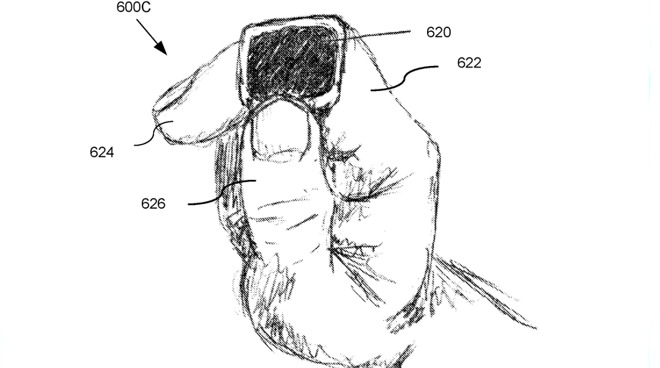Apple is continuing to research creating an Apple Ring that could replace certain Apple Watch functionality -- and maybe use a U1 chip to also identify what other device a user is pointing at.

As well as internal sensors that register where a finger is being pointed, the ring could have a touch screen
Building on a prior patent application regarding a wearable smart ring, Apple has now added a plan for such a device to include point detection. That is, when a user performs a gesture on the ring, they may now be able to point at their other devices.
"Devices, methods, and graphical user interfaces for a wearable electronic ring computing device," US Patent No. 10,627,902, starts by describing the benefits of a ring over devices such as an iPhone, or to an extent even a MacBook Pro.
"The use of touch-sensitive surfaces as input devices for computers and other electronic computing devices has increased significantly in recent years," it says. "Use of existing touchpads and touch-screen displays, however, may be cumbersome, inconvenient, or inefficient for certain tasks and applications."
"A user's hands may be preoccupied with another task, for example, or the user's hands and/or arms may become fatigued after holding the device in a viewing position for extended periods of time," it continues. "The light emitted by a touchscreen may be inappropriate in certain social environments or even dangerous if it gives away the position of a threatened user."
Aside from that scary last proposition, the patent's examples of problems can be seen to relate to screen issues that Apple both does and does not do. For instance, the business about a user's hands being occupied could be a tacit acknowledgement that iPhone screens are now so big that users struggle to control them single-handedly.
Equally, the issue regarding viewing positions could be a nod to how Apple repeatedly claims that there won't be a touchscreen MacBook Pro because it's ergonomically uncomfortable.
Whether these examples are really a dig at Apple or its rivals, the patent makes a strong case for how these devices we all use could be bettered.
"Furthermore, switching back-and-forth between different input modes, such as a keyboard and mouse, may be inefficient," it continues. "A need therefore exists for a more discreet, safer, more efficient, or more ergonomic way to interact with touch pads or touch screens."
Apple believes that a smart ring is the answer, and while you're not going to be doing Photoshop drawing on your index finger's ring, what you can do is control other devices.
"[A ring gives a user] faster, more efficient methods and interfaces for controlling external electronic devices," says Apple, "thereby increasing the effectiveness, efficiency, and user satisfaction with such devices."
"For example, the ring computing device is more portable than a mouse, doesn't require a computer, doesn't require eye contact with the touch screen, allows the user to not be tied to a computer, cellular phone, or tablet to certain control electronic devices (e.g., televisions), reduces the inefficiencies of mode switching by not requiring a user to move his or her hand off a keyboard to move a mouse or touchpad, and is smaller, more portable, and less obtrusive than existing devices."
Apple could've added the words "so there," to the end of all that, except there's more.
"The ring computing device can be operated using a single hand; the ring does not need to be put aside when, for example, the user needs to hold another object. The ring computing device can be carried unobtrusively for periods of time by the user and used when the user requires (to, for example, control light of a room as the user enters the room or to control devices at work or in a car). The ring computing device can also receive information from external devices in the form of messages or images on a touchscreen, pulses or vibrations of haptic actuators, and sound."
The patent also describes various ways in which a ring could be charged, here including a connector on a car steering wheel
So a little ring could be a remarkable controller for other devices and a receiver of information. It could give distinctive notification taps that tell the user whether there's a message or some other form of alert. It could work with HomeKit to unlock a user's front door or turn on their lights, for instance.
While all of this has been covered to some extent in a previous version of this patent, the new one specifically adds a method by which the user can specify which device they want to do something with.
"[The ring] detects an input, and, in response...[transmits instructions] in accordance with a determination that a predefined hand gesture directed toward a first external electronic device was performed,"says the patent.
If you have two HomePods, for instance, you could point at the one you want to turn up the volume on. Perhaps if you need to show your iPhone screen on a nearby monitor, you could activate AirPlay by pointing at which display you want.
All of this requires the ability for a ring to detect a gesture, and for it and the intended device, to recognize that the user is pointing. While the patent makes no reference to it, the logical inference is that this could be a use for Ultra Wideband.
Apple's U1 chip, introduced in the iPhone 11 and iPhone 11 Pro, is so far only used for speeding up the selection of a device during AirDrop. If a user is pointing their phone at another U1-enabled iPhone, then that is the one that appears at the top of the AirDrop list.
Ultra Wideband is for short-range and very precise location tracking, though, so it's seemed certain that Apple has plans for more elaborate uses for it. This updated smart ring patent could be that.


